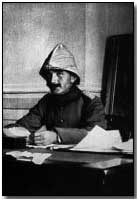Battles - The Turkish Counter-attack at Eski Hissarlik, 1915
 Three days after the Allies
- under British commander
Aylmer
Hunter-Weston - had attempted to break north from Cape Helles in an
attempt to capture Krithia and its nearby prominent hill feature Achi Baba
(the First Battle of
Krithia), Turkish forces operating under
Liman von Sanders
struck back in a counter-strike designed to push the Allied force back into
the sea.
Three days after the Allies
- under British commander
Aylmer
Hunter-Weston - had attempted to break north from Cape Helles in an
attempt to capture Krithia and its nearby prominent hill feature Achi Baba
(the First Battle of
Krithia), Turkish forces operating under
Liman von Sanders
struck back in a counter-strike designed to push the Allied force back into
the sea.
Liman - an attached German officer in command of Turkish forces on the Gallipoli peninsular - had received a firm directive from Turkish war minister Enver Pasha requiring him to organise a night attack against the combined British and French beachhead at Cape Helles.
Consequently at 10pm on the night of 1 May 1915 a concerted attack was launched by 21 Turkish battalions directly following a brief artillery bombardment. The British in particular had however been well drilled to prepare for just such a night attack and consequently manned their positions rapidly.
Nevertheless breaking through in two locations the Turkish infantry were subsequently thrown back by the arrival of timely Allied reinforcements. The line to the right, manned by French Sengalese troops, caved in and required assistance from the Royal Naval Division and 4th Worcesters.
Turkish infantry losses were accordingly heavy as the British cut down troops advancing across open country in waves. The French under General d'Amade suffered some 2,000 casualties (and the British rather fewer).
On the night of 3 May Liman repeated the night attack of two days earlier. It was to prove equally unsuccessful in the face of brutally effective French field batteries.
Three days, on 6 May 1916, later the Allies renewed their own assault upon Krithia and Achi Baba during the Second Battle of Krithia. It was to prove similarly unsuccessful.
To view maps detailing the progress of the Gallipoli campaign click here; and here; and here; and here.
Photograph courtesy of Photos of the Great War website
"Drum Fire" was an artillery barrage fired not in salvo but by each gun in succession.
- Did you know?
